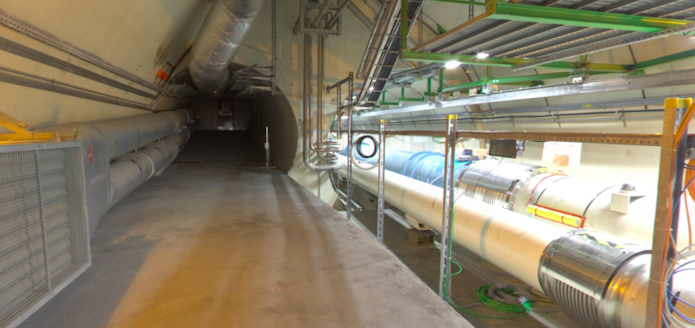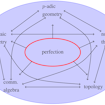Announcing a New Hunt for Undiscovered Particles at CERN’s Large Hadron Collider

The Large Hadron Collider in Geneva is getting an upgrade. A new experiment at the particle accelerator will hunt for new fundamental particles including dark photons, dark Higgs bosons and sterile neutrinos.
The research board at CERN (the European Organization for Nuclear Research), which operates the LHC, has approved the Forward Search Experiment, or FASER. Initiated by physicists at the University of California, Irvine, the multiyear FASER project is funded by grants of $1 million each from the Heising-Simons Foundation and the Simons Foundation, with additional support from CERN. The experiment will operate along the beam trajectory of the LHC, which creates new particles by smashing protons together at nearly the speed of light.
“The FASER project promises to extend the science reach of the collider in a rapid and inexpensive way,” says Jochen Marschall, program officer for science at the Heising-Simons Foundation. “These types of opportunities are rare, and we are excited to support it.”
The project “has a relatively low cost with a potential for a breakthrough discovery,” says Gregory Gabadadze, associate director of physics at the Simons Foundation.
FASER’s purpose is to find light, extremely weakly interacting particles that have so far eluded scientists, even in the high-energy experiments conducted at the LHC, the largest particle accelerator in the world.
“Seven years ago, scientists discovered the Higgs boson at the Large Hadron Collider, completing one chapter in our search for the fundamental building blocks of the universe, but now we are looking for new particles,” says FASER co-leader Jonathan Feng, a professor of physics and astronomy at UCI. “The dark matter problem shows that we don’t know what most of the universe is made of, so we’re sure new particles are out there.”
Feng, a theoretical physicist, will be joined by CERN collaborators as well as other scientists from research institutions in Europe, China, Japan and the United States. The FASER team will consist of 30 to 40 members, a small group compared to other teams conducting research at the LHC.

The FASER instrument is compact, measuring about 1 meter in diameter and 5 meters in length. It will be placed at a point along the 16-mile loop of the LHC about 480 meters (1,574 feet) away from the hulking, six-story instrument that was used by the ATLAS collaboration to discover the Higgs boson.
As proton beams pass through the interaction point at the ATLAS instrument, they may create new particles that will go through concrete in the LHC tunnel and then into the FASER instrument, which will track and measure the progress of their decay. FASER will collect data any time ATLAS is operating.
“One of the advantages of our design is that we’ve been able to borrow many of the components of FASER — silicon detectors, calorimeters and electronics — from the ATLAS and LHCb collaborations,” says Jamie Boyd, a CERN research scientist and co-spokesperson for the project. “That’s allowing us to assemble an instrument that costs hundreds of times less than the largest experiments at the LHC.”
Another advantage is FASER’s rapid construction schedule. According to FASER experimental physicist Dave Casper, an associate professor of physics and astronomy at UCI, graduate students joining the team now will be able to participate in the complete life cycle of the experiment — from assembly and installation to data gathering and reporting on results. Seeing an experiment through the entire process is something that scientists on larger LHC projects could only dream of, since some experiments have taken decades to design and build.
The FASER detector, which will be one of only eight research instruments at the LHC, is being built and installed during the collider’s current hiatus and will collect data from 2021 to 2023. The LHC will be shut down again from 2024 to 2026. During that time, the team hopes to install the larger FASER 2 detector, which will be capable of unveiling an even wider array of mysterious hidden particles.
This area of research has strong links to past UCI efforts. Founding faculty member Frederick Reines won the Nobel Prize in 1995 for his co-discovery of neutrinos in 1956.
“In some sense, we’re following that tradition by looking for extremely weakly interacting light particles, like the neutrino,” Feng says. “We now know that neutrinos make up some chunk of the universe but far less than 1 percent of the dark matter. We’re trying to find out what makes up the rest.”
Press Contacts
Heising-Simons Foundation
Nondas Paschos
650-492-6908
communications@hsfoundation.org
Simons Foundation
Anastasia Greenebaum
212-524-6097
communications@simonsfoundation.org
University of California, Irvine
Brian Bell
949-824-8249
bpbell@uci.edu


